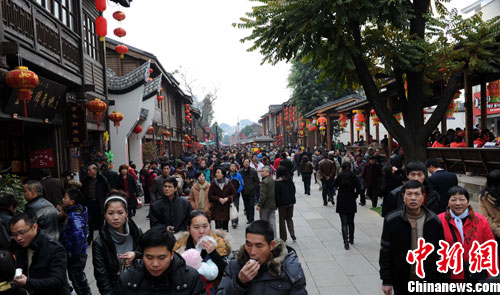Fuzhou (CNS) -- The San Fang Qi Xiang, which is composed of over 200 ancient buildings from the Ming and Qing dynasties, all within three lanes and seven alleys, was constructed into the first museum in China which has preserved an entire community, including its ancient architecture and cultural objects.
The "museum," divided into one central pavilion, 37 special pavilions, and 24 exhibition spots by regions, traditions, memories, and residents, was opened to the public recently.
The Courtyard of the Lius
As the central hall, the yard of the Lius is the biggest civil house in Fujian with an area of 4,532 square meters. It was built by the Liu family who ran the business of waterpower and electrical engineering. Celebrated writer Yu Dafu once resided here.
Now it not only is valuable in its own exhibitions, but also serves as the information center of the community.
After the renovation work, the delicate gates, walls, attics, and even the hidden layers were restored and preserved in good condition, noticed a visitor named Chen Xiangrong.
The courtyard is the symbol of Fujian's glorious history during its business growth. Even though 100 years have passed, the architecture is still an extraordinary piece of work. One of the Liu's offspring was also impressed by the efforts the administration has taken to maintain the courtyard.
The Ancestral Temple of the Xies
The temple, which used to be where the revolutionary Lin Juemin lived, now holds a large storeroom of over 500 civil collections, including paintings and calligraphies of Qi Baishi, Xu Beihong, and Fu Baoshi, as well as furniture, official wares and blue and white porcelain from the Qing Dynasty.
Of unique timid beauty, the temple attic is of the typical local building style, with patterns of peonies, bats, the god of longevity, and plums.
A precious repository of the Xinhai Revolution
The former residence of Lin Juemin and famous writer Bingxin was converted into the memorial hall of the Revolution of 1911, also known as the Xinhai Revolution.
Visitors are provided with both the knowledge and life details of the two celebrities and a rich photographical source of the people and incidents in Fuzhou concerned with the revolution. Among them are about 100 objects, graphs, or other documents, including five photos of Sun Yat-sen during his stay in Fuzhou.
The San Fang Qi Xiang Museum has involved the evolution of both local businesses and culture in one single interactive community.
Visitor Lin Tao held the view that historical and cultural maintenance should be carried on without disturbance from modern business drives, especially when it comes to a priceless zone like the San Fang Qi Xiang.



















